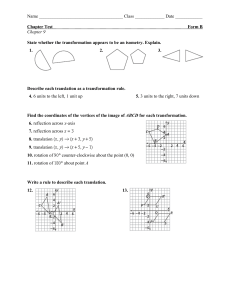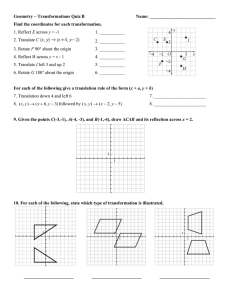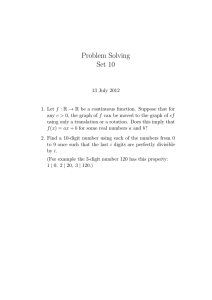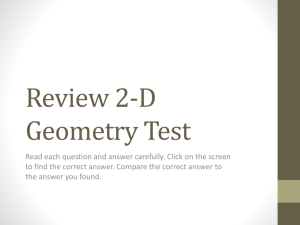OPTIMIZATION OF AUTOMATIC IMAGE REGISTRATION ALGORITHMS AND CHARACTERIZATION
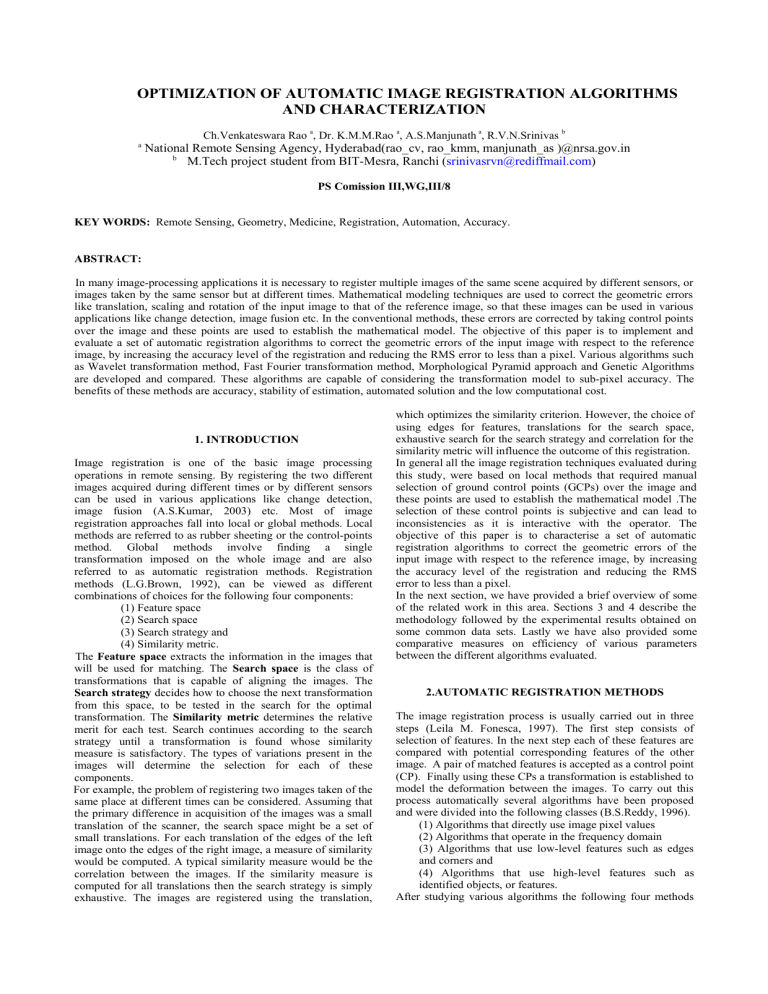
OPTIMIZATION OF AUTOMATIC IMAGE REGISTRATION ALGORITHMS
AND CHARACTERIZATION
Ch.Venkateswara Rao a , Dr. K.M.M.Rao a , A.S.Manjunath
a , R.V.N.Srinivas b a
National Remote Sensing Agency, Hyderabad(rao_cv, rao_kmm, manjunath_as )@nrsa.gov.in
b
M.Tech project student from BIT-Mesra, Ranchi ( srinivasrvn@rediffmail.com
)
PS Comission III,WG,III/8
KEY WORDS: Remote Sensing, Geometry, Medicine, Registration, Automation, Accuracy.
ABSTRACT:
In many image-processing applications it is necessary to register multiple images of the same scene acquired by different sensors, or images taken by the same sensor but at different times. Mathematical modeling techniques are used to correct the geometric errors like translation, scaling and rotation of the input image to that of the reference image, so that these images can be used in various applications like change detection, image fusion etc. In the conventional methods, these errors are corrected by taking control points over the image and these points are used to establish the mathematical model. The objective of this paper is to implement and evaluate a set of automatic registration algorithms to correct the geometric errors of the input image with respect to the reference image, by increasing the accuracy level of the registration and reducing the RMS error to less than a pixel. Various algorithms such as Wavelet transformation method, Fast Fourier transformation method, Morphological Pyramid approach and Genetic Algorithms are developed and compared. These algorithms are capable of considering the transformation model to sub-pixel accuracy. The benefits of these methods are accuracy, stability of estimation, automated solution and the low computational cost.
1. INTRODUCTION
Image registration is one of the basic image processing operations in remote sensing. By registering the two different images acquired during different times or by different sensors can be used in various applications like change detection, image fusion (A.S.Kumar, 2003) etc. Most of image registration approaches fall into local or global methods. Local methods are referred to as rubber sheeting or the control-points method. Global methods involve finding a single transformation imposed on the whole image and are also referred to as automatic registration methods. Registration methods (L.G.Brown, 1992), can be viewed as different combinations of choices for the following four components:
(1) Feature space
(2) Search space
(3) Search strategy and
(4) Similarity metric.
The Feature space extracts the information in the images that will be used for matching. The Search space is the class of transformations that is capable of aligning the images. The
Search strategy decides how to choose the next transformation from this space, to be tested in the search for the optimal transformation. The Similarity metric determines the relative merit for each test. Search continues according to the search strategy until a transformation is found whose similarity measure is satisfactory. The types of variations present in the images will determine the selection for each of these components.
For example, the problem of registering two images taken of the same place at different times can be considered. Assuming that the primary difference in acquisition of the images was a small translation of the scanner, the search space might be a set of small translations. For each translation of the edges of the left image onto the edges of the right image, a measure of similarity would be computed. A typical similarity measure would be the correlation between the images. If the similarity measure is computed for all translations then the search strategy is simply exhaustive. The images are registered using the translation, which optimizes the similarity criterion. However, the choice of using edges for features, translations for the search space, exhaustive search for the search strategy and correlation for the similarity metric will influence the outcome of this registration.
In general all the image registration techniques evaluated during this study, were based on local methods that required manual selection of ground control points (GCPs) over the image and these points are used to establish the mathematical model .The
selection of these control points is subjective and can lead to inconsistencies as it is interactive with the operator. The objective of this paper is to characterise a set of automatic registration algorithms to correct the geometric errors of the input image with respect to the reference image, by increasing the accuracy level of the registration and reducing the RMS error to less than a pixel.
In the next section, we have provided a brief overview of some of the related work in this area. Sections 3 and 4 describe the methodology followed by the experimental results obtained on some common data sets. Lastly we have also provided some comparative measures on efficiency of various parameters between the different algorithms evaluated.
2.AUTOMATIC REGISTRATION METHODS
The image registration process is usually carried out in three steps (Leila M. Fonesca, 1997). The first step consists of selection of features. In the next step each of these features are compared with potential corresponding features of the other image. A pair of matched features is accepted as a control point
(CP). Finally using these CPs a transformation is established to model the deformation between the images. To carry out this process automatically several algorithms have been proposed and were divided into the following classes (B.S.Reddy, 1996).
(1) Algorithms that directly use image pixel values
(2) Algorithms that operate in the frequency domain
(3) Algorithms that use low-level features such as edges and corners and
(4) Algorithms that use high-level features such as identified objects, or features.
After studying various algorithms the following four methods
were identified to cover, one from each class.
Wavelet-Modulus Maxima method (Leila M. Fonesca, 1997), uses image pixel values, similar to that described in (Q. Zheng,
1993) except determining the feature selection. The probable control points are detected from the local modulus maxima of the wavelet transform, applied to the input and reference images, after performing the wavelet decomposition up to two levels. The correlation coefficient is used as a similarity measure and only the best pair-wise fitting, among all pairs of feature points, are taken as actual control points. A polynomial transform, which can take care of translation and rotational errors, is then used to model the deformation between the images and their parameters are estimated in a coarse to fine manner. The refinement matching is achieved using the warped image and the set of feature points detected in the reference image. After processing all levels the final parameters are determined and used to warp the original input image.
Fast Fourier Transform (FFT) technique (B.S.Reddy, 1996,
Y.Keller, 2002) is a frequency domain approach in which it does not use any control points, instead the FFT ratio is computed. The displacement between two given images can be determined by computing the ratio F1.conj(F2)/|F1.F2
|, the inverse of this ratio results as an impulse like function. This is approximately zero everywhere except at the displacement, this determines the translation error between the images. Converting these images from rectangular coordinates to log-polar coordinates and by calculating the similar ratio, we can represent rotation and scaling errors also as shifts. These three parameters are used to establish the mathematical model and the image is geometrically rectified with respect to the reference image.
Morphological Pyramid Image Registration algorithm
(Zhongxiu HU, 2000) uses the low level shape features to determine the global affine transformation model along with the radiometric changes between the images. The multi resolution images are represented by a Morphological Pyramid (MP), as the MP’s have the capability to eliminate details and to maintain shape features. The Levenberg Marquardt non-linear optimization algorithm is employed to estimate the matching parameters of translation, rotation and scaling errors up to sub pixel accuracy. In this approach intensity mapping function is integrated into geometric mapping function.
Image Registration using Genetic Algorithms (GAs) (J.H.
Holland, 1975) uses the comparison of identified solutions to ensure a population’s survival under changing environmental conditions. GAs are iterative procedures that maintain a population of candidate solutions encoded in the form of chromosome strings. The initial population can be generated randomly. These candidates will be selected using a selection criterion for the reproduction in the next generation based on their fitness values.
GAs search is used to efficiently explore the huge solution space required by the image registration to a sub pixel accuracy.
3. METHODOLOGY
Mathematical modeling techniques are used to correct the geometric errors like translation, rotation and scaling of the input image to that of the reference image. Let the image to be warped be called the input image and to which it is reduced is called the reference image. There are two cases to consider for the image registration algorithms:
a) The images have the same ground resolution (pixel size)
b) The images are taken from different sensors and have different ground resolutions.
Each of the above algorithms models the same deformation in its own way. The input image needs to be interpolated while warping. The simplest scheme for gray-level interpolation is based on the nearest neighbor approach called zero-order interpolation. But the nearest neighbor interpolation yields undesirable artifacts such as stair-stepped effect around diagonal lines and the curves. Bilinear interpolation produces the output images that are smoother and without the stair stepped effect. It’s a reasonable compromise between smoothness and computational cost.
3.1 Wave let-Modulus Maxima method
As the wavelet approach (Leila M. Fonesca, 1997), assumes that the images have the same ground resolution, so the image with the highest resolution is reduced to the lower resolution.
After reducing the images to the same spatial resolution, compute the discrete multi-resolution wavelet transform (L levels). This helps in decomposing the signal into the coarser resolution, which consists of the low frequency approximation information and the high frequency detail information called sub bands. During the decomposition, the resolution decreases exponentially at the base of 2. For generating the sub bands the algorithm proposed in (S.G.Mallat 1989), is used for its computational efficiency. In sub band coding, an image is decomposed into a set of band-limited components, called sub bands, which can be reassembled to reconstruct the original image without error. We call LL, LH, HL, HH the four images created at each level of decomposition. When the decomposition level j decreases, the resolution decreases in the spatial domain and increases in the frequency domain. The next phase aims to identify features that are present in both images in each level of decomposition. The modulus maxima of the wavelet transform is used to detect sharp variation points, which correspond to edge points in the images.Let us call a smoothing function Φ(x, y), the impulse response of a 2-D lowpass filter. The first order derivative of Φ(x,y) decomposed in two components along the x and y directions , respectively, are
∂ Φ (x, y)
ψ 1 (x, y) = —————
(1)
∂x
∂ Φ (x, y)
ψ 2 (x, y) = ————— (2)
∂y and these functions can be used as wavelets. For calculating the partial derivatives, the difference between each pixel and its adjacent pixel is calculated. This difference is calculated both in the x and y directions, separately. For any function f, the wavelet transform at scale a=2 j defined with respect to these two wavelets has two components.
W 1
2 j [f(x,y)] = f * ψ 1
2
= f * (2
= 2 j j j (x,y)
∂/∂x Φ
∂/∂x(f * Φ
2 j
2 j (x,y))
)(x,y) (3)
W 2
2 j [f(x,y)] = f * ψ
= f * (2
= 2 j
2
2 j j (x,y)
∂/∂y Φ
∂/∂y(f *Φ
2 j
2 j (x,y))
)(x,y) (4)
Therefore, these two components of the wavelet transform are proportional to the coordinates of the gradient vector of f(x,y) smoothened by Φ
2 j (x,y). They characterize the singularities along x and y directions, respectively.
M[f(2 j
M[f(2 j
,x,y)]=(| W
,x,y)] > T
1
2 j
2 j
[f(x,y)]| 2 + | W 2
2 j [f(x,y)]| 2 ) 1/2 (5)
(6)
Which is the modulus of the wavelet transform at the scale
2 j .The maximum of the differences calculated at each pixel in the x and y directions are squared and summed and their square root is taken, which will be the modulus maxima (5). A threshold procedure is applied on the wavelet transform modulus image in order to eliminate non-significant feature points. Then, a point (x ,y) is recorded only if (6) is valid.
T
2 j = α(σ
2 j + μ
2 j ), α is a constant whose initial value is defined by the user and σ
2 j and μ
2 j are the standard deviation and mean of the wavelet transform modulus image at level 2 j respectively. The parameter α controls the number of feature points selected . Since the number of feature points increases in
, the finer resolutions the parameter α is also increased in the higher levels in order to select the most significant feature points in the images. The matching pairs of control points are identified using correlation. Reliable matches can be identified through consistency check and RMSE verification, which are used to determine a warping model that gives the best registration of the LL sub bands to the precision available at that level. Solving the warping model and determining the unknown coefficients create new pixel locations. Bilinear interpolation can assign gray values to these new locations. The point matching and image warping steps can be performed at progressively higher resolutions in a similar fashion to that described. The refinement matching is achieved using the warped image and the set of feature points detected in the reference image. After processing all levels the final parameters are determined and used to warp the original input image. The implementation issues are discussed in the next section.
3.2 FFT TECHNIQUE
The FFT- based automatic registration algorithm relies on the
Fourier shift theorem (De Castro, 1987), if two images I
1
and I
2 differ only by a shift, (x
0
, y
0
), i.e. I
2
(x, y)= I
1
[x- x
0
, y-y
0
], then their Fourier transforms are related by
Where K is a structuring element, d is a down sampling factor, o and ● are open and close filters. Thus the image at any level L can be created. The spatial-mapping function and parameters in
MPIR are described by a global affine transformation. The global affine transformation (Allieny .S 1986, L.G. Brown
1982), includes translation (tx, ty), rotation (θ), scaling (sx, sy), and shearing (shx, shy). g1(X) = a1x+a2y+a5 (10) g1(y) = a3x+a4y+a6 (11)
In addition to these errors this approach compensate for brightness and contrast (P.Thevenaz, 1998) variation between the images. The intensity-mapping function is defined as g
2
= a
7
g
1
+ a
8
(12)
F (ξ,η) = e -j2ξ(xξ +yη ) F1(ξ,η)
The ratio of two images I
1
and I
2
is defined as
(7)
F1 (ξ,η) * conj ( F(ξ,η ))
R = ————————————— (8)
Abs (F1 (ξ,η)) * abs (F (ξ,η))
Where conj is the complex conjugate, and abs is absolute value.
By taking the Inverse Fourier Transform of R, we see that the resulting function is approximately zero every-where except for a small neighborhood around a single point (B.S.Reddy,
1996) . This single point is where the absolute value of the
Inverse Fourier Transform of R attains its maximum value. It can be shown that the location of this point is exactly the displacement (x
0
, y
0
), needed to optimally register the images.
Then converting these images from rectangular coordinates (x, y) to log-polar coordinates (log (r,θ)) makes it possible to represent both rotation and scaling as shifts. To transfer the image from rectangular to log-polar coordinates (Young. D,
2000) the steps of the angle (Dtheta) and the logarithmic base
(b) are calculated. In order to attain high accuracy, we must require that the polar plane have the same number of rows as the rectangular plane. The implementation issues are discussed in the next section.
3.3 MORPHOLOGICAL PYRAMID APPROACH
Mathematical morphology is a set-theoretic approach to image analysis (Zhongxiu Hu , 2000). The morphological filters, such as open and close, can be designed to preserve edges or shapes of objects, while eliminating noise and details in an image.
Successive application of morphological filtering and sub sampling (A. Morales, 1995) can construct the Morphological
Pyramid (MP) of an image:
I
L
= [ ( I
L-1 g
o K) ● K] ↓ d
2
(r,c)=[ a
7
g
L=0,1,2,…n (9) g
1 and g
2 are the gray scale images. Levenberg - Marquardt
(LM) algorithm used to estimate the transformation parameters iteratively. The LM nonlinear optimization algorithm is well suited for performing registration based on least-squares criterion. Combining the spatial mapping and the intensity mapping functions, we achieve the complete relationship between the two input images:
1
(p,q) +a
8
] + n(r,c) (13)
where n(r,c) is due to noise existing in both images, and the eight transformation parameters a k
, k = 1, 2, … , 8 are estimated using the intensity-based method for matching, since registration methods based on initial intensity values can make effective use of all data available. The parameters (a1 to a8) are estimated by the procedure similar to (Y.Keller, 2002). The implementation issues are discussed in the next section.
3.4 REGISTRATION USING GENETIC ALGORITHM
Highest similarity between the input and the reference images indicates the proper registration of images. This similarity can be achieved by properly identifying the correct transformation procedure. Unlike traditional linear search, the GAs adaptively explore the search solution space in a hyper - dimension fashion (J.H. Holland, 1975, D.E. Goldburg, 1989), so that they can improve computational efficiency.
GAs are iterative procedures that maintain a population of candidate solutions encoded in the form of chromosome strings. A chromosome is a vector of length n of the form <x1, x2, …, xn>, where each xi is an allele or gene. The type of a gene can be binary digit, integer, or floating-point number.
Binary genes are widely used in GA applications. The initial population can be generated randomly. Each candidate is evaluated and is assigned the fitness value that is generally a function of the decoded bits contained in each candidate’s chromosome. These candidates will be selected using selection criteria for the reproduction, based on their fitness values.
Reproduction process uses three basic genetic operations called
Selection, Crossover and Mutation.
The selected candidates are combined using the genetic recombination operation “crossover” to produce the next generation. The “mutation” is then applied to perturb the bits of the chromosome as to guarantee that the probability of searching a particular subspace of the problem space is never zero (Q. Zheng, 1993). It also prevents the algorithm from becoming trapped on local optima(Hongjie Xie, 2003, D.E.
Goldburg 1989). The whole population is evaluated again in the next generation and the process continues until it reaches the termination criteria which can be triggered by finding an acceptable approximate solution, or reaching a specific number of generations, or until the solution converges.
4.EXPERIMENTAL RESULTS
Indian Remote Sensing (IRS) PAN data sets are used to test these algorithms. Common data set of 512X512 is used to test all the algorithms, which is extracted from larger data sets to reduce processing time. The two data sets are acquired by the same sensor but at two different times. Figure 1 shows the data that is used as a reference image. Figure 2 shows the data which is to be warped.
Figure-1 Reference Image
4.1 WAVELET MODULUS MAXIMA APPROACH
The wavelet decomposition is carried out upto the third level.
The actual feature point matching is achieved by maximizing the correlation coefficient over small windows surrounding the points with the LL sub bands of the wavelet
Figure-2 Input Image to be warpe d transform. A point from the input image is taken and its correlations with all the points from the reference image are calculated. Then, the point with which it has the maximum correlation is its most similar feature point. A constant α=2.5 is used to control the number of feature points selected for the matching in the modulus maxima. In order to select the most significant feature points α is also in the higher levels. A
Correlation threshold T c
= 0.85 is defined to limit the number of matched control point pairs. If the achieved correlation is greater than this threshold, then both the points are matched.
= 7, the size of refinement The area of matching window w c matching window w r
= 3 is chosen for finding the correlation.
We have taken care of the well distribution of the control points through out the image by splitting the image into 5X5 grids and in each grid minimum of one control point is selected. The actual consistency check(H. Li, 1995) is done in an iterative fashion through which the most likely incorrect match is identified recursively in each step. If RMSE is too large, another round of consistency check is carried out. The iteration continues until acceptable RMSE is achieved. This first part of the matching process is the crucial phase of the registration process. The algorithm is progressive at higher levels of wavelet sub bands to improve the registration accuracy. The
RMSE at the finer level is achieved as 0.45 pixels. Fig 3 shows the warped image.
4.2 FAST FOURIER TRANSOFROM APPROACH
Rotation and Scale can be represented as shifts in the log – polar coordinates. From this log – polar images (Young.D,
2000) by using phase correlation and Fourier shift theorem rotation and scale is derived. But while computing the log – polar image from the original rectangular coordinates leads to points that are not located exactly at points in the original grid.
This demands the interpolation. In this implementation bilinear interpolation is adopted. An image is simulated for known errors of translation and rotation. The simulated image is shown in Figure 4. The corresponding log – polar image is shown in
Figure 5. To implement this algorithm IDL/ENVI(Hongjie
Xie, 2003) is being used. The FFT of the log – polar images of both input and reference images are created. By using the
Inverse FFT of the phase correlation ratio, the maximum
Figure 3 Warped Imge using Wavelet Modulus Maxima absolute value and location indicates the rotation and scale. A new image constructed by applying the rotation and scale and it is created by using bilinear interpolation. Once again by finding the phase correlation ratio of the newly generated image with the reference image, shift between the images are identified.
The maximum absolute value of the Inverse FFT of this ratio provides the shifts in both x and y directions. After deriving all
Figure 5 Log – Polar image of simulated image degrees. When the rectified image is swiped on the reference image it could be observed easily for its well registration.
Figure 6 shows the rectified image.
Figure 4 Simulated Image to be warped using FFT the three parameters of translation, rotation and scale, the input image is warped by taking care of all the three errors simultaneously, to avoid multiple re-sampling of the image. To test this algorithm an IRS PAN images of different dates are
“simulated” for rotation of 9 degrees, translation in X is 12 and in Y is –10 pixels. Due to the same sensors data scale factor is same. This algorithm could identify the shifts exactly but only the rotation is identified as 9.09 degrees instead of 9
Figure 6 Warped Image using FFT
4.3 MORPHOLOGICAL PYRAMID APPROACH
The MPIR technique minimizes the SSE between two images based on the intensity for matching, since registration methods based on initial intensity values can make effective use of all data available. This technique uses an optimization scheme of coarse-to-fine iterative refinement strategy over the MP pair
(Zhongxiu Hu, 2000). Based on the matching criteria, convergence indication can be obtained. Once convergence has been achieved at a particular pyramid level a transition to finer level is made. The solution from the previous pyramid level is used as an initial estimate. The new incremental estimate is
computed by minimizing the SSE between the re-sampled images g
1 and image g
2.
. This whole process is iterated at each pyramid level to achieve the final estimation. Gray scale MPs are created using 3X3 structuring element and then subsampling the filtered image with d = 2. The initial estimated parameters are identified arbitrarily. Using Levenberg –
Marquardt algorithm by verifying the matching criteria the parameters a
0
to a
7 are iteratively identified in each of the pyramid levels.
4.4 REGISTRATUION USING GENETICS APPROACH
Randomly initialize the population, sufficiently large to be representative of the search as a whole. Each chromosome is of length 32 bits(Prachya, 1999) allocates 12bits for rotation, 10 bits for translation in x-direction and 10 more bits for translation in y-direction. Each field is a signed magnitude binary number. A precision factor is used to improve the accuracy. Evaluate the fitness function for each solution in the population to see if the termination criteria for optimality are met. In our case study correlation is used as fitness function.
Used a weighted roulette wheel sampling to reproduce strings of the next generation in proportion to their fitness. Evaluate the fitness of each new individual. Thus we obtain a solution string or chromosome, which is used to transform the image using affine transformation and bilinear interpolation.
Population size and number of generations were limited to 150, regstration accuracy observed as less than a pixel.
5. CONCLUSIONS
Wavelet Modulus Maxima appraoch assumes the images are of same resolution. In this method threshold parameters need to be interactively provided. Due to pyramidal approach it allows for faster implementation and higher registering precision. It is more adequate to register images taken from the same sensor.
It worked well for images taken at different times, which are typical to remote sensing applications. Since this uses the control points approach it can rectify the local errors, which emulates manual registration of images. FFT technique provides accuracy acceptably good. The algorithm works for images in which the scale change is less than 1.8 (Hongjie Xie,
2003). Due to the global transform this approach cannot determine local geometric distortions. The MPIR algorithm with an intensity-based differential matching technique is reliable and efficient. This algorithm capable of measuring the errors, to sub pixel accuracy, the displacement between images subjected to affine transformation, which includes simultaneous translation, rotation, scaling, and shearing. GAs can efficiently search the solution space and gives the solution to achieve the sub pixel accuracy without identifying the control points.
Through global transformation a model can be established for translation and rotation errors. The proposed algorithm expects both the images are of same scale. Computational efficiency can be improved by adopting the pyramidal approach.
Depending on the type of variations in the medical images of
Computerized Tomography, PET or MRI images some of these techniques can be adopted for making the various observations.
It is unlikely that a single registration scheme will work satisfactorily. To characterize these algorithms the common data sets from IRS PAN are used and there is no scale variation.
ACKNOWLEDGEMENTS
The authors would like to thank Dr. R. R. Naval gund, Director
NRSA for encouraging us to carry out this work at NRSA.
REFFERENCES
Alliney, S., Anij Morandi, C. 1986, Digital image registration using projections IEEE Trans. PAMI-8, 2 (Mar.), 222-233.
A. Morales, T. Acharya, and S. Ko, “Morphological pyramids with alternating sequential filters”, IEEE Trans. Image
Processing, vol.4, pp. 965-977, 1995.
A.S.Kumar, A.S.Manjunath and K.M.M. Rao , “ Merging IRS-
Multispectral and PAN images by A-Trous wavelets”. Int.
Journal of Remote Sensing , 2003 (communicated).
B.S.Reddy and B.N.Chatterji, “An FFT-based technique for translation, rotation and scale invariant image registration”,
IEEE Transactions on Image Processing, 5(8): 1266 –
1271,1996.
De Castro E, and Morandi C, 1987. Registration of translated and rotated images using finite Fourier Transforms, IEEE
Trans. PAMI-9, 5 (Sept.),700-703.
D. E. Goldburg, Genetic Algorithms in Search: optimization and machine learning, Reading, Mass. Addison-Wesley,1989.
H. Li, B. S. Manjunath, and S. K. Mitra, “A contour-based approach to multisensor image registration,” IEEE Trans.Image
Processing, vol.4, pp. 320-334, 1995.
Hongjie Xie,NigelHicks,G.randy Keller Haitao Huang ,”An
IDL/ENVI implementation of the FFT-based algorithm for automatic image registration” .Int.Jl of Computers and
Geosciences, vol .29 ,pp 1045-1055, 2003.
J. H. Holland, “Adaptation in Natural and Artificial System,”
University of Michigan Press, Ann Arbor, 1975.
L.G. Brown, “A survey of image registration techniques,”
ACM Computer Surveys, vol. 24, pp325-376, 1992.
Leila M.Fonesca and Max H.M.Costa,”Automatic Regestration of Satellite Images”,Proceedings on IEEE transaction of computer society,1997,pp 219-226.
Prachya Chalermwat, Tarek A. El-Chazawi “Multi resolution image registration using Genetics, ICIP(2) 1999:452-456.
P. Thevenaz, U.E. Ruttimann, and M. Unser, “A pyramid approach to sub pixel registration based on intensity,” IEEE
Trans. Image Processing, vol.7, pp. 27-41, 1998.
Q.Zheng and R.A.Chellappa. “Computational vision approach to image registraion”. IEEE Transactions on Image Processing,
2(3) : 311-326, July 1993.
S.G. Mallat “A theory for multi-resolution signal decomposition: the wavelet representation.” IEEE Trans. On
Pattern Anal. And Machine Intell. , 11(7):674-693, July 1989.
Y.Keller, A.Averbuch, “FFT Based Image Registration”,IEEE international conference – ICASSP 2002. Orlando.
YOUNG.D “Straight lines and circles in the log-polar image”.
Proceedings of the British Machine Vision Conference 2000,
BMVC, 2000, Bristol, UK, 11-14 September 2000, pp 426-435
Zhongxiu Hu and Scott T.Acton,”Morphological Pyramid
Image Registration” 4 th IEEE south west symposium 2000.
P227.

